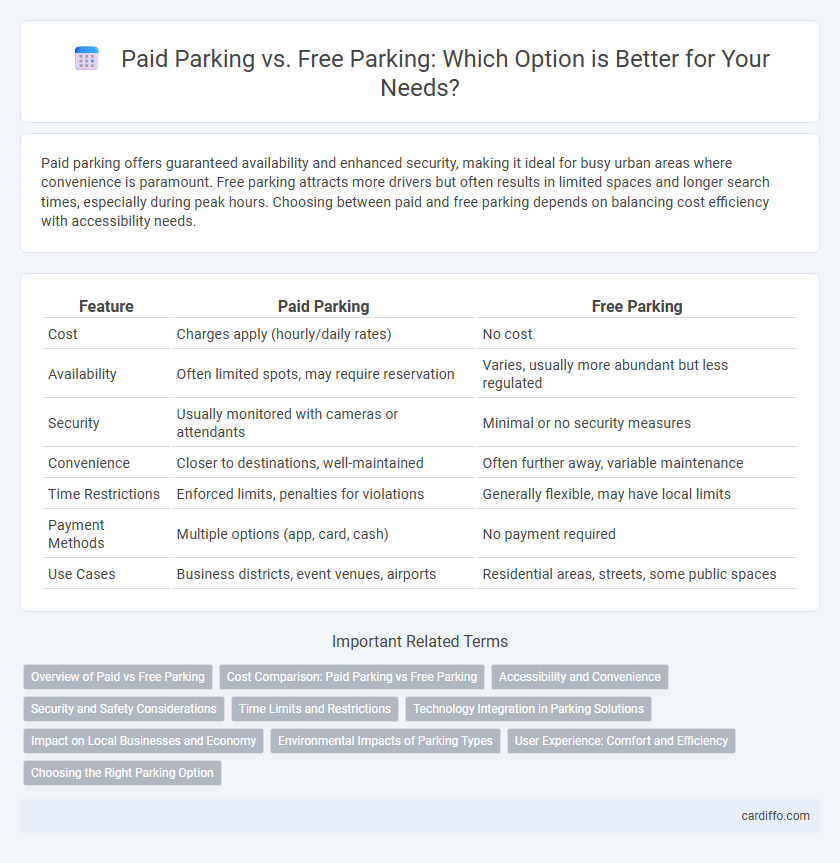Paid parking offers guaranteed availability and enhanced security, making it ideal for busy urban areas where convenience is paramount. Free parking attracts more drivers but often results in limited spaces and longer search times, especially during peak hours. Choosing between paid and free parking depends on balancing cost efficiency with accessibility needs.
Table of Comparison
| Feature | Paid Parking | Free Parking |
|---|---|---|
| Cost | Charges apply (hourly/daily rates) | No cost |
| Availability | Often limited spots, may require reservation | Varies, usually more abundant but less regulated |
| Security | Usually monitored with cameras or attendants | Minimal or no security measures |
| Convenience | Closer to destinations, well-maintained | Often further away, variable maintenance |
| Time Restrictions | Enforced limits, penalties for violations | Generally flexible, may have local limits |
| Payment Methods | Multiple options (app, card, cash) | No payment required |
| Use Cases | Business districts, event venues, airports | Residential areas, streets, some public spaces |
Overview of Paid vs Free Parking
Paid parking offers a structured system where users pay fees based on duration or location, generating consistent revenue for maintenance and urban development. Free parking provides cost savings to users but often results in higher demand, congestion, and limited availability. Urban planners weigh these factors to balance accessibility, efficiency, and economic impact in city environments.
Cost Comparison: Paid Parking vs Free Parking
Paid parking typically involves direct expenses ranging from hourly rates to daily or monthly fees, which can significantly impact commuters and visitors in urban areas. Free parking eliminates these costs but often leads to indirect expenses such as increased time spent searching for spaces, higher vehicle emissions, and potential traffic congestion. Businesses and municipalities must weigh the economic benefits of paid parking revenue against the convenience and accessibility offered by free parking options.
Accessibility and Convenience
Paid parking offers enhanced accessibility by guaranteeing available spaces through reservation systems and real-time availability updates, reducing the time spent searching for spots. Free parking often lacks these features, resulting in limited convenience and increased difficulty finding accessible spaces, particularly in high-demand areas. Convenience in paid parking also includes closer proximity to key destinations and secure facilities, improving overall user experience.
Security and Safety Considerations
Paid parking facilities often feature enhanced security measures such as surveillance cameras, gated access, and regular patrols, reducing risks of theft and vandalism. Free parking areas may lack these protective features, increasing vulnerability to damage or personal safety concerns. Prioritizing secure lighting and monitored spaces in paid options improves overall safety for both vehicles and pedestrians.
Time Limits and Restrictions
Paid parking typically enforces strict time limits and restrictions, ensuring higher turnover and availability for short-term users. Free parking often lacks precise time constraints, resulting in longer vehicle stays and reduced space turnover. Time restrictions in paid parking zones are usually clearly marked and monitored, while free parking areas may have ambiguous or inconsistent enforcement.
Technology Integration in Parking Solutions
Paid parking systems increasingly leverage advanced technology integration, such as automated payment kiosks, mobile app-based reservations, and license plate recognition for efficient access control. Free parking areas often lack such sophisticated technological infrastructure, leading to challenges in space management and monitoring. Smart parking solutions enhance user experience and operational efficiency by utilizing real-time data analytics and IoT devices to optimize space utilization in paid parking zones.
Impact on Local Businesses and Economy
Paid parking generates steady revenue streams that local governments can reinvest in urban development and public services, enhancing the overall economic environment for businesses. It can encourage higher turnover of parking spaces, increasing foot traffic and sales opportunities for nearby shops and restaurants. Free parking attracts more visitors initially but may lead to congestion and limited space availability, potentially deterring customers and reducing local business profitability.
Environmental Impacts of Parking Types
Paid parking reduces vehicle circulation and congestion by encouraging shorter parking durations, which decreases emissions and improves air quality in urban areas. Free parking often leads to excessive driving and prolonged parking, contributing to higher fuel consumption and increased greenhouse gas emissions. Implementing paid parking policies supports sustainable urban mobility and helps mitigate environmental degradation associated with vehicle emissions.
User Experience: Comfort and Efficiency
Paid parking often enhances user experience by offering guaranteed availability and well-maintained spaces, reducing the time spent searching for a spot. Free parking can lead to challenges such as overcrowding and limited security, which may decrease overall comfort and efficiency. Efficient paid parking systems with digital payment options further streamline the process, improving convenience for users.
Choosing the Right Parking Option
Choosing the right parking option depends on convenience, cost, and time constraints, with paid parking offering guaranteed spots and security in busy areas. Free parking is ideal for budget-conscious drivers but often involves longer walking distances or limited availability. Evaluating location, duration, and personal priorities helps determine the most efficient and cost-effective parking choice.
Paid Parking vs Free Parking Infographic

 cardiffo.com
cardiffo.com